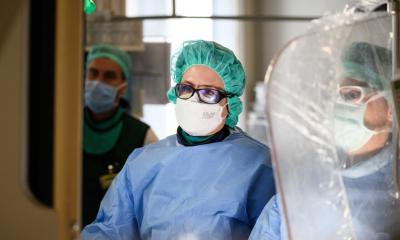Video • TCAR (Transcarotid artery revascularization)
Reversing blood flow reduces stroke risk during carotid artery procedure
Loyola Medicine is the first academic medical center in Illinois to use the TCAR system, which reduces stroke risk during carotid artery procedures by temporarily reversing blood flow.
Carotid arteries on each side of the neck supply blood to the brain. In patients with carotid artery disease, a build-up of plaque can cause blockages. A common method to open the artery involves a balloon angioplasty and stent placement. The physician inserts a balloon catheter in the groin and guides it through various blood vessels up to the carotid artery. At the site of the blockage, the tiny balloon is inflated to open the artery. A stent then is placed to ensure the artery remains open. The procedure can knock loose pieces of plaque, and the debris can travel to the brain and cause a stroke. The traditional way to prevent this is to place an umbrella-shaped filter in the carotid artery. However, small pieces of plaque can still make it through the filter and cause small strokes. Also, placing the filter itself can knock loose plaque debris.
Throughout the procedure, we constantly monitor the patient's neurological status, and if necessary, we can stop the reversal of blood flow
Paul Crisostomo
TCAR (Transcarotid artery revascularization) prevents debris from flowing up to the brain during the procedure. The carotid artery is connected to a system that reverses the flow of blood away from the brain. The blood is filtered and returned to the femoral vein in the patient's thigh. After the stent procedure is completed, the TCAR system is removed and blood flow returns to normal.
During the TCAR procedure, the brain continues to receive oxygenated blood from other arteries, including the carotid artery on the other side of the neck and vertebral arteries in the back of the neck. "Throughout the procedure, we constantly monitor the patient's neurological status, and if necessary, we can stop the reversal of blood flow," said Loyola vascular surgeon Paul Crisostomo, MD. Dr. Crisostomo said TCAR prevents strokes more effectively than any umbrella filters previously used.
Dr. Crisostomo and other surgeons in Loyola Medicine's division of vascular surgery and endovascular therapy use the latest open and less invasive endovascular procedures to treat a wide variety of arterial diseases. In addition to carotid stenting, procedures offered include carotid endarterectomy (open carotid surgery), angioplasty, aortic aneurysm repair, atherectomy, bypass surgery, endovenous laser therapy and radiofrequency ablation. Vascular surgeons collaborate closely with other specialists, including neurologists, neurological surgeons, radiologists, cardiologists and cardiothoracic surgeons.
Source: Loyola University Health System
06.02.2018











